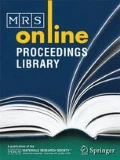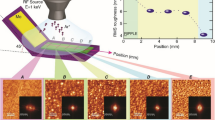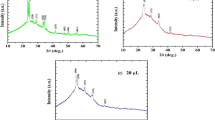Abstract
Si surface cleaning has been studied intensively in these days. One of the major concerns is about the removal of metallic impurities on Si surface. In this study we choose contaminant element of Cu which shows high electronegativity value compared to Si’s. The Si substrate was cleaned with using piranha (H2SO4:H2O2=4:1) and HF (HF:H2O=1:100) solutions to eliminate the organic impurities and native oxide. The initial Si substrate was then contaminated intentionally by dipping into the 1 ppm standard solution of Cu and cleaned by the cleaning splits of the chemical solution HF combined with UV/O3 treatment and the chemical mixture of H2O2 and HF. The initial substrates which were contaminated with the standard Cu solution exhibited the contamination levels of 1013–1015 atoms/cm2 and these substrates were cleaned and showed Cu concentration down to the levels as lower as 1010 atom/cm2 which were monitored by TXRF (total reflection X-ray fluorescence). And repeated treatments of these cleaning splits improved the surface microroughness of these initial substrate which were measured by AFM (atomic force microscope). The surface and interface morphologies contaminated with Cu were examined by SEM (scanning electron microscope) and TEM (transmission electron microscope). It was observed that Cu impurities were adsorbed on Si surface not in a thin film but in a particle form as a hemispherical shape. The chemical composition of Cu impurities and interface between Cu and Si substrate was investigated by AES (Auger electron spectroscope). The result exhibited that Cu element adsorbed on Si surface by chemical adsorption and this resulted in oxidation of Si substrate.
Similar content being viewed by others
References
K. Saga, and T. Hattori, J. Electrochem. Soc., 143, 3279(1996)
D. K. Schroder, IEEE Trans. Electron Dev., ED–29, 1336(1982)
Z. Radzimski, J. Honeycutt, and G. A. Rozgonyi, IEEE Trans. Electron Dev., ED–35, 80(1988)
K. Ryoo, and R. K. Graupner, Materials Science and Engineering, B4, 251(1989)
G. Zoth, and W. Bergholz, J. Appl. Phys., 67, 6764(1990)
T. Ohmi, T. Imaoka, I. Sugiyama, and T. Kezuka, J. Electrochem. Soc., 139, 3317(1992)
J. Alay, S. Verhaverbeke, W. Vandervorst, and M. Heyns, Jpn. J. Appl. Phys., 32, 358(1993)
J. Yoshinobu, S. Tanaka, and M. Nishijima, Jpn. J. Appl. Phys., 32. 1191(1993)
W. Kern, and D. A. Puotinen, RCA., Rev 31, 187(1970)
H. Park, C. R. Helms, D. Ko, M. Tran, and B. B. Triplett, Mat. Res. Soc. Symp. Proc., 315, 353(1993)
Steven Verhaverbeke, Dielectric breakdown in thermally grown oxide layers, 75–77(1993)
H. Morinaga, M. Suyama, and T. Ohmi, J. Electrochem. Soc., 141, 2834(1994)
H. Aomi, F. Derouin, and T. Ohmi, Mat. Res. Soc. Proc., 315, 333(1993).
S.M. Sze, ULSI Technology, Mcgrawhill 66–71(1996)
H. Jeon, H. Choi, and T. Ahn, J. Korea. Phys. Soc., 29, 781(1996)
H. Jeon, H. Choi, Y. Cho, K. Ryoo, and S. Jung, Mat. Res. Soc. Proc., 386, 297(1995)
J. Ruzyllo, A. M. Hoff, D. C. Frystak, and S. D. Hossain, J. Electrochem. Soc., 136, 1602(1989)
J. Cho, T. P. Schneider, J. Vanderweide, H. Jeon, and R. J. Nemanich, Appl. Phys. Lett., 59, 1995 (1992)
D. J. Monk, D. S. Soane, and R. T. Howe, J. Electrochem. Soc., 141, 264(1994)
Acknowledgments
This study was supported by the Ministry of Education (Semiconductor Field, ISRC-96-E-1047)
Author information
Authors and Affiliations
Rights and permissions
About this article
Cite this article
Jeon, H., Choi, B. Comparison of Removal Efficiency of Cu Impurity on Si(100) Depending on the Cleaning Splits of (UV/O3 + HF) and (H2O2 + HF). MRS Online Proceedings Library 477, 253–258 (1997). https://doi.org/10.1557/PROC-477-253
Published:
Issue Date:
DOI: https://doi.org/10.1557/PROC-477-253




